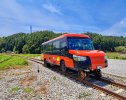At the beginning of 1931 the London, Midland and Scottish Railway Co. after much experimental work carried out in conjunction with Karrier Motors, Ltd., Huddersfield, held demonstrations of a vehicle called the Ro-Railer, which was virtually a motor coach capable of travelling either on the road or on the railway track ; the machine was described in our issue dated February 3rd, 1931.
As announced briefly in our issue for last week, a road-service licence has been obtained for operation between the Welcombe Hotel, Stratford-on-Avon, which is one of the L.M.S. hotels, and Blisworth Station, on the main line from Euston to Holyhead, Glasgow, etc.
The service commenced last Saturday week, and will operate once daily in each direction until further notice. Ten minutes are ellowed for converting the four wheels for operation on the rails. The journey comprises about one mile on the road and something like 30 miles on the rail.


